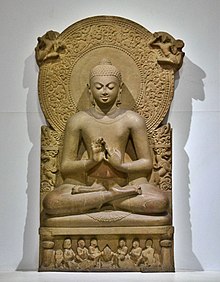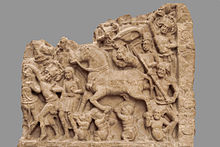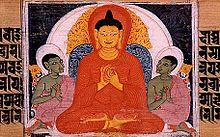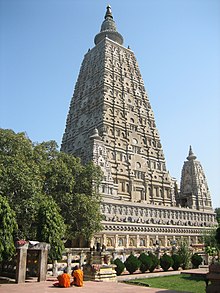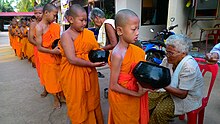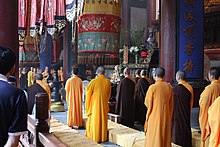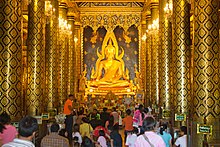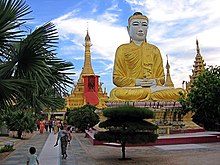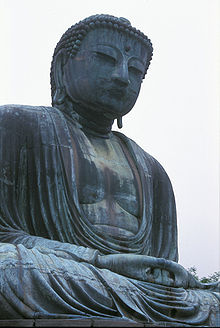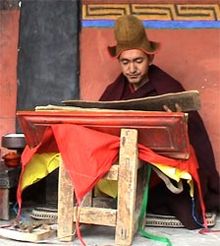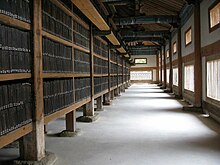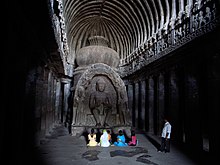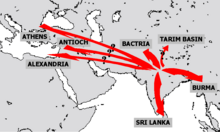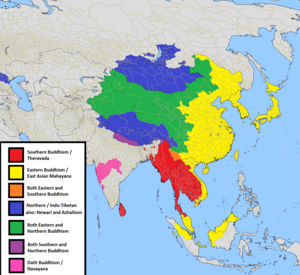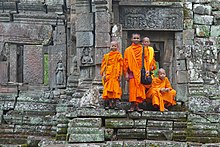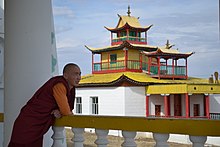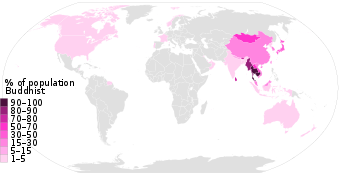Buddhism
Definition
Buddhism (/ˈbʊdɪzəm/, US also /ˈbuː-/) is the world's fourth-largest religion with over 520 million followers, or over 7% of the global population, known as Buddhists. An Indian religion, Buddhism encompasses a variety of traditions, beliefs and spiritual practices largely based on original teachings attributed to the Buddha and resulting interpreted philosophies. Buddhism originated in Ancient India as a Sramana tradition sometime between the 6th and 4th centuries BCE, spreading through much of Asia. Two major extant branches of Buddhism are generally recognized by scholars: Theravada (Pali: "The School of the Elders") and Mahayana (Sanskrit: "The Great Vehicle").
All Buddhist traditions share the goal of overcoming suffering and the cycle of death & rebirth, either by the attainment of Nirvana or through the path of Buddhahood. Buddhist schools vary in their interpretation of the path to liberation, the relative importance and canonicity assigned to the various Buddhist texts, and their specific teachings and practices. Widely observed practices include taking refuge in the Buddha, the Dharma and the Sangha, observance of moral precepts, monasticism, meditation, and the cultivation of the Paramitas (virtues).
Theravada Buddhism has a widespread following in Sri Lanka and Southeast Asia. Mahayana, which includes the traditions of Pure Land, Zen, Nichiren Buddhism, Shingon and Tiantai (Tendai), is found throughout East Asia.
Vajrayana, a body of teachings attributed to Indian adepts, may be viewed as a separate branch or as an aspect of Mahayana Buddhism. Tibetan Buddhism, which preserves the Vajrayana teachings of eighth century India, is practiced in the countries of the Himalayan region, Mongolia, and Kalmykia.
Life of the Buddha
Buddhism is an Indian religion attributed to the teachings of the Buddha, supposedly born Siddhārtha Gautama, and also known as the Tathagata ("thus-gone") and Sakyamuni ("sage of the Sakyas"). The details of Buddha's life are mentioned in many Early Buddhist Texts but are inconsistent, and his social background and life details are difficult to prove, the precise dates uncertain.
The evidence of the early texts suggests that he was born as Siddhārtha Gautama in Lumbini and grew up in Kapilavasthu, a town in the plains region of the modern Nepal-India border, and that he spent his life in what is now modern Bihar and Uttar Pradesh. Some hagiographic legends state that his father was a king named Suddhodana, his mother was queen Maya, and he was born in Lumbini gardens. However, scholars such as Richard Gombrich consider this a dubious claim because a combination of evidence suggests he was born in the Shakyas community – one that later gave him the title Shakyamuni, and the Shakya community was governed by a small oligarchy or republic-like council where there were no ranks but where seniority mattered instead. Some of the stories about Buddha, his life, his teachings, and claims about the society he grew up in may have been invented and interpolated at a later time into the Buddhist texts.
According to the Buddhist sutras, Gautama was moved by the innate suffering of humanity and its endless repetition due to rebirth. He set out on a quest to end this repeated suffering. Early Buddhist canonical texts and early biographies of Gautama state that Gautama first studied under Vedic teachers, namely Alara Kalama (Sanskrit: Arada Kalama) and Uddaka Ramaputta (Sanskrit: Udraka Ramaputra), learning meditation and ancient philosophies, particularly the concept of "nothingness, emptiness" from the former, and "what is neither seen nor unseen" from the latter.
Finding these teachings to be insufficient to attain his goal, he turned to the practice of asceticism. This too fell short of attaining his goal, and then he turned to the practice of dhyana, meditation, which he had already discovered in his youth. He famously sat in meditation under a Ficus religiosa tree now called the Bodhi Tree in the town of Bodh Gaya in the Gangetic plains region of South Asia. He gained insight into the workings of karma and his former lives, and attained enlightenment, certainty about the Middle Way (Skt. madhyamā-pratipad)as the right path of spiritual practice to end suffering (dukkha) from rebirths in Saṃsāra. As a fully enlightened Buddha (Skt. samyaksaṃbuddha), he attracted followers and founded a Sangha (monastic order). Now, as the Buddha, he spent the rest of his life teaching the Dharma he had discovered, and died at the age of 80 in Kushinagar, India.
Buddha's teachings were propagated by his followers, which in the last centuries of the 1st millennium BCE became over 18 Buddhist sub-schools of thought, each with its own basket of texts containing different interpretations and authentic teachings of the Buddha; these over time evolved into many traditions of which the more well known and widespread in the modern era are Theravada, Mahayana and Vajrayana Buddhism.
The problems of life: dukkha and saṃsāra
Four Noble Truths – dukkha and its ending
The Four Truths express the basic orientation of Buddhism: we crave and cling to impermanent states and things, which is dukkha, "incapable of satisfying" and painful. This keeps us caught in saṃsāra, the endless cycle of repeated rebirth, dukkha and dying again. But there is a way to liberation from this endless cycle to the state of nirvana, namely following the Noble Eightfold Path.
The truth of dukkha is the basic insight that life in this mundane world, with its clinging and craving to impermanent states and things is dukkha, and unsatisfactory. Dukkha can be translated as "incapable of satisfying," "the unsatisfactory nature and the general insecurity of all conditioned phenomena"; or "painful." Dukkha is most commonly translated as "suffering," but this is inaccurate, since it refers not to episodic suffering, but to the intrinsically unsatisfactory nature of temporary states and things, including pleasant but temporary experiences. We expect happiness from states and things which are impermanent, and therefore cannot attain real happiness.
In Buddhism, dukkha is one of the three marks of existence, along with impermanence and anattā (non-self). Buddhism, like other major Indian religions, asserts that everything is impermanent (anicca), but, unlike them, also asserts that there is no permanent self or soul in living beings (anattā). The ignorance or misperception (avijjā) that anything is permanent or that there is self in any being is considered a wrong understanding, and the primary source of clinging and dukkha.
Dukkha arises when we crave (Pali: tanha) and cling to these changing phenomena. The clinging and craving produces karma, which ties us to samsara, the round of death and rebirth. Craving includes kama-tanha, craving for sense-pleasures; bhava-tanha, craving to continue the cycle of life and death, including rebirth; and vibhava-tanha, craving to not experience the world and painful feelings.
Dukkha ceases, or can be confined, when craving and clinging cease or are confined. This also means that no more karma is being produced, and rebirth ends. Cessation is nirvana, "blowing out," and peace of mind.
By following the Buddhist path to moksha, liberation, one starts to disengage from craving and clinging to impermanent states and things. The term "path" is usually taken to mean the Noble Eightfold Path, but other versions of "the path" can also be found in the Nikayas. The Theravada tradition regards insight into the four truths as liberating in itself.
The cycle of rebirth
Saṃsāra
Saṃsāra means "wandering" or "world", with the connotation of cyclic, circuitous change. It refers to the theory of rebirth and "cyclicality of all life, matter, existence", a fundamental assumption of Buddhism, as with all major Indian religions. Samsara in Buddhism is considered to be dukkha, unsatisfactory and painful, perpetuated by desire and avidya (ignorance), and the resulting karma.
The theory of rebirths, and realms in which these rebirths can occur, is extensively developed in Buddhism, in particular Tibetan Buddhism with its wheel of existence (Bhavacakra) doctrine. Liberation from this cycle of existence, nirvana, has been the foundation and the most important historical justification of Buddhism.
The later Buddhist texts assert that rebirth can occur in six realms of existence, namely three good realms (heavenly, demi-god, human) and three evil realms (animal, hungry ghosts, hellish). Samsara ends if a person attains nirvana, the "blowing out" of the desires and the gaining of true insight into impermanence and non-selfreality.
Rebirth
Rebirth refers to a process whereby beings go through a succession of lifetimes as one of many possible forms of sentient life, each running from conception to death. In Buddhist thought, this rebirth does not involve any soul, because of its doctrine of anattā(Sanskrit: anātman, no-self doctrine) which rejects the concepts of a permanent self or an unchanging, eternal soul, as it is called in Hinduism and Christianity. According to Buddhism there ultimately is no such thing as a self in any being or any essence in any thing.
The Buddhist traditions have traditionally disagreed on what it is in a person that is reborn, as well as how quickly the rebirth occurs after each death. Some Buddhist traditions assert that "no self" doctrine means that there is no perduring self, but there is avacya (inexpressible) self which migrates from one life to another.The majority of Buddhist traditions, in contrast, assert that vijñāna (a person's consciousness) though evolving, exists as a continuum and is the mechanistic basis of what undergoes rebirth, rebecoming and redeath. The rebirth depends on the merit or demerit gained by one's karma, as well as that accrued on one's behalf by a family member.
Each rebirth takes place within one of five realms according to Theravadins, or six according to other schools – heavenly, demi-gods, humans, animals, hungry ghosts and hellish.
In East Asian and Tibetan Buddhism, rebirth is not instantaneous, and there is an intermediate state (Tibetan "bardo") between one life and the next. The orthodox Theravada position rejects the wait, and asserts that rebirth of a being is immediate. However there are passages in the Samyutta Nikaya of the Pali Canon that seem to lend support to the idea that the Buddha taught about an intermediate stage between one life and the next.
Karma
In Buddhism, karma (from Sanskrit: "action, work") drives saṃsāra – the endless cycle of suffering and rebirth for each being. Good, skilful deeds (Pali: "kusala") and bad, unskilful deeds (Pāli: "akusala") produce "seeds" in the unconscious receptacle (ālaya) that mature later either in this life or in a subsequent rebirth. The existence of karma is a core belief in Buddhism, as with all major Indian religions, it implies neither fatalism nor that everything that happens to a person is caused by karma.
A central aspect of Buddhist theory of karma is that intent (cetanā) matters and is essential to bring about a consequence or phala "fruit" or vipāka "result". However, good or bad karma accumulates even if there is no physical action, and just having ill or good thoughts create karmic seeds; thus, actions of body, speech or mind all lead to karmic seeds. In the Buddhist traditions, life aspects affected by the law of karma in past and current births of a being include the form of rebirth, realm of rebirth, social class, character and major circumstances of a lifetime. It operates like the laws of physics, without external intervention, on every being in all six realms of existence including human beings and gods.
A notable aspect of the karma theory in Buddhism is merit transfer. A person accumulates merit not only through intentions and ethical living, but also is able to gain merit from others by exchanging goods and services, such as through dāna (charity to monks or nuns). Further, a person can transfer one's own good karma to living family members and ancestors.
Liberation
The cessation of the kleshas and the attainment of nirvana (nibbāna), with which the cycle of rebirth ends, has been the primary and the soteriological goal of the Buddhist path for monastic life since the time of the Buddha. The term "path" is usually taken to mean the Noble Eightfold Path, but other versions of "the path" can also be found in the Nikayas. In some passages in the Pali Canon, a distinction is being made between right knowledge or insight (sammā-ñāṇa), and right liberation or release (sammā-vimutti), as the means to attain cessation and liberation.
Nirvana literally means "blowing out, quenching, becoming extinguished". In early Buddhist texts, it is the state of restraint and self-control that leads to the "blowing out" and the ending of the cycles of sufferings associated with rebirths and redeaths. Many later Buddhist texts describe nirvana as identical with anatta with complete "emptiness, nothingness". In some texts, the state is described with greater detail, such as passing through the gate of emptiness (sunyata) – realizing that there is no soul or self in any living being, then passing through the gate of signlessness (animitta) – realizing that nirvana cannot be perceived, and finally passing through the gate of wishlessness (apranihita) – realizing that nirvana is the state of not even wishing for nirvana.
The nirvana state has been described in Buddhist texts partly in a manner similar to other Indian religions, as the state of complete liberation, enlightenment, highest happiness, bliss, fearlessness, freedom, permanence, non-dependent origination, unfathomable, and indescribable. It has also been described in part differently, as a state of spiritual release marked by "emptiness" and realization of non-self.
While Buddhism considers the liberation from saṃsāra as the ultimate spiritual goal, in traditional practice, the primary focus of a vast majority of lay Buddhists has been to seek and accumulate merit through good deeds, donations to monks and various Buddhist rituals in order to gain better rebirths rather than nirvana.
The path to liberation: Bhavana (practice, cultivation)
While the Noble Eightfold Path is best-known in the west, a wide variety of practices and stages have been used and described in the Buddhist traditions. Basic practices include sila (ethics), samadhi (meditation, dhyana) and prajna (wisdom), as described in the Noble Eightfold Path. An important additional practice is a kind and compassionate attitude toward every living being and the world. Devotion is also important in some Buddhist traditions, and in the Tibetan traditions visualizations of deities and mandalas are important. The value of textual study is regarded differently in the various Buddhist traditions. It is central to Theravada and highly important to Tibetan Buddhism, while the Zen tradition takes an ambiguous stance.
Refuge in the Three Jewels
Traditionally, the first step in most Buddhist schools requires taking Three Refuges, also called the Three Jewels (Sanskrit: triratna, Pali: tiratana) as the foundation of one's religious practice. Pali texts employ the Brahmanical motif of the triple refuge, found in the Rigveda 9.97.47, Rigveda 6.46.9 and Chandogya Upanishad2.22.3–4. Tibetan Buddhism sometimes adds a fourth refuge, in the lama. The three refuges are believed by Buddhists to be protective and a form of reverence.
The Three Jewels are:
- The Buddha, the Gotama, the Blessed One, the Awakened with true knowledge
- The Dharma, the precepts, the practice, the Four Truths, the Eightfold Path
- The Sangha, order of monks, the community of Buddha's disciples
Reciting the three refuges is considered in Buddhism not as a place to hide, rather a thought that purifies, uplifts and strengthens.
The Buddhist path
Theravada – Noble Eightfold Path
An important guiding principle of Buddhist practice is the Middle Way (madhyamapratipad). It was a part of Buddha's first sermon, where he presented the Noble Eightfold Path that was a 'middle way' between the extremes of asceticism and hedonistic sense pleasures. In Buddhism, states Harvey, the doctrine of "dependent arising" (conditioned arising, pratītyasamutpāda) to explain rebirth is viewed as the 'middle way' between the doctrines that a being has a "permanent soul" involved in rebirth (eternalism) and "death is final and there is no rebirth" (annihilationism).
In the Theravada canon, the Pali-suttas, various often irreconcilable sequences can be found. According to Carol Anderson, the Theravada canon lacks "an overriding and comprehensive structure of the path to nibbana." Nevertheless, the Noble Eightfold Path, or "Eightfold Path of the Noble Ones", has become an important description of the Buddhist path. It consists of a set of eight interconnected factors or conditions, that when developed together, lead to the cessation of dukkha. These eight factors are: Right View (or Right Understanding), Right Intention (or Right Thought), Right Speech, Right Action, Right Livelihood, Right Effort, Right Mindfulness, and Right Concentration.
This Eightfold Path is the fourth of the Four Noble Truths, and asserts the path to the cessation of dukkha (suffering, pain, unsatisfactoriness). The path teaches that the way of the enlightened ones stopped their craving, clinging and karmic accumulations, and thus ended their endless cycles of rebirth and suffering.
The Noble Eightfold Path is grouped into three basic divisions, as follows:
| Division | Eightfold factor | Sanskrit, Pali | Description |
|---|---|---|---|
| Wisdom (Sanskrit: prajñā, Pāli: paññā) | 1. Right view | samyag dṛṣṭi, sammā ditthi | the belief that there is an afterlife and not everything ends with death, that Buddha taught and followed a successful path to nirvana; according to Peter Harvey, the right view is held in Buddhism as a belief in the Buddhist principles of karma and rebirth, and the importance of the Four Noble Truths and the True Realities. |
| 2. Right intention | samyag saṃkalpa, sammā saṅkappa | giving up home and adopting the life of a religious mendicant in order to follow the path; this concept, states Harvey, aims at peaceful renunciation, into an environment of non-sensuality, non-ill-will (to lovingkindness), away from cruelty (to compassion). | |
| Moral virtues (Sanskrit: śīla, Pāli: sīla) | 3. Right speech | samyag vāc, sammā vāca | no lying, no rude speech, no telling one person what another says about him, speaking that which leads to salvation; |
| 4. Right action | samyag karman, sammā kammanta | no killing or injuring, no taking what is not given; no sexual acts in monastic pursuit, for lay Buddhists no sensual misconduct such as sexual involvement with someone married, or with an unmarried woman protected by her parents or relatives. | |
| 5. Right livelihood | samyag ājīvana, sammā ājīva | For monks, beg to feed, only possessing what is essential to sustain life. For lay Buddhists, the canonical texts state right livelihood as abstaining from wrong livelihood, explained as not becoming a source or means of suffering to sentient beings by cheating them, or harming or killing them in any way. | |
| Meditation (Sanskrit and Pāli: samādhi) | 6. Right effort | samyag vyāyāma, sammā vāyāma | guard against sensual thoughts; this concept, states Harvey, aims at preventing unwholesome states that disrupt meditation. |
| 7. Right mindfulness | samyag smṛti, sammā sati | never be absent minded, conscious of what one is doing; this, states Harvey, encourages mindfulness about impermanence of the body, feelings and mind, as well as to experience the five skandhas, the five hindrances, the four True Realities and seven factors of awakening. | |
| 8. Right concentration | samyag samādhi, sammā samādhi | Correct meditation or concentration (dhyana), explained as the four jhānas. |
Mahayana – Bodhisattva-path and the six paramitas
Mahāyāna Buddhism is based principally upon the path of a Bodhisattva. A Bodhisattva refers to one who is on the path to buddhahood. The term Mahāyāna was originally a synonym for Bodhisattvayāna or "Bodhisattva Vehicle."
In the earliest texts of Mahayana Buddhism, the path of a bodhisattva was to awaken the bodhicitta. Between the 1st and 3rd century CE, this tradition introduced the Ten Bhumi doctrine, which means ten levels or stages of awakening. This development was followed by the acceptance that it is impossible to achieve Buddhahood in one (current) lifetime, and the best goal is not nirvana for oneself, but Buddhahood after climbing through the ten levels during multiple rebirths. Mahayana scholars then outlined an elaborate path, for monks and laypeople, and the path includes the vow to help teach Buddhist knowledge to other beings, so as to help them cross samsara and liberate themselves, once one reaches the Buddhahood in a future rebirth. One part of this path are the Pāramitā (perfections, to cross over), derived from the Jatakas tales of Buddha's numerous rebirths.
The Mahayana texts are inconsistent in their discussion of the Paramitas, and some texts include lists of two, others four, six, ten and fifty-two. The six paramitas have been most studied, and these are:
- Dāna pāramitā: perfection of giving; primarily to monks, nuns and the Buddhist monastic establishment dependent on the alms and gifts of the lay householders, in return for generating religious merit; some texts recommend ritually transferring the merit so accumulated for better rebirth to someone else
- Śīla pāramitā: perfection of morality; it outlines ethical behaviour for both the laity and the Mahayana monastic community; this list is similar to Śīla in the Eightfold Path (i.e. Right Speech, Right Action, Right Livelihood)
Kṣānti pāramitā: perfection of patience, willingness to endure hardship- Vīrya pāramitā: perfection of vigour; this is similar to Right Effort in the Eightfold Path
- Dhyāna pāramitā: perfection of meditation; this is similar to Right Concentration in the Eightfold Path
- Prajñā pāramitā: perfection of insight (wisdom), awakening to the characteristics of existence such as karma, rebirths, impermanence, no-self, dependent origination and emptiness; this is complete acceptance of the Buddha teaching, then conviction, followed by ultimate realization that "dharmas are non-arising".
In Mahayana Sutras that include ten Paramitas, the additional four perfections are "skillful means, vow, power and knowledge". The most discussed Paramita and the highest rated perfection in Mahayana texts is the "Prajna-paramita", or the "perfection of insight". This insight in the Mahayana tradition, states Shōhei Ichimura, has been the "insight of non-duality or the absence of reality in all things".
Śīla – Buddhist ethics
Śīla (Sanskrit) or sīla (Pāli) is the concept of "moral virtues", that is the second group and an integral part of the Noble Eightfold Path. It consists of right speech, right action and right livelihood.
Śīla appear as ethical precepts for both lay and ordained Buddhist devotees. It includes the Five Precepts for laypeople, Eight or Ten Precepts for monastic life, as well as rules of Dhamma (Vinaya or Patimokkha) adopted by a monastery.
Precepts
The five precepts (panca-sila) are moral behavioural and ritual guidelines for lay devotees in Buddhism, while those following a monastic life have rules of conduct (patimokkha). The five precepts apply to both male and female devotees, and these are:
- Abstain from killing (Ahimsa);
- Abstain from stealing;
- Abstain from sensual (including sexual) misconduct;
- Abstain from lying;
- Abstain from intoxicants.
These precepts are not commandments and transgressions do not invite religious sanctions, but their power has been in the Buddhist belief in karmic consequences and their impact in afterlife during rebirth. Killing in Buddhist belief leads to rebirth in the hellish realm, and for a longer time in more severe conditions if the murder victim was a monk. Adultery, similarly, invites a rebirth as prostitute or in hell, depending on whether the partner was unmarried or married. Saving animals from slaughter for meat, is believed to be a way to acquire merit for better rebirth. These moral precepts have been voluntarily self-enforced in lay Buddhist culture through the associated belief in karma and rebirth.
The monastic life in Buddhism has additional precepts as part of patimokkha, and unlike lay people, transgressions by monks do invite sanctions. Full expulsion from sangha follows any instance of killing, engaging in sexual intercourse, theft or false claims about one's knowledge. Temporary expulsion follows a lesser offence.The sanctions vary by the monastic fraternity (nikaya).
The precepts for monks in many Buddhist fraternities are eight (asta shila) or ten (das shila). Four of these are same as for the lay devotee: no killing, no stealing, no lying, and no intoxicants. The other four precepts are:
- No sexual activity;
- Abstain from eating at the wrong time (e.g. only eat solid food before 12 noon);
- Abstain from jewellery, perfume, adornment, entertainment;
- Abstain from sleeping on high beds;
Some sangha add two more precepts: abstain from dancing and singing, and abstain from accepting money. In addition to these precepts, Buddhist monasteries have hundreds of rules of dhamma conduct, which are a part of its patimokkha.
Vinaya
Vinaya is the specific code of conduct for a sangha of monks or nuns. It includes the Patimokkha, a set of 227 offences including 75 rules of decorum for monks, along with penalties for transgression, in the Theravadin tradition. The precise content of the Vinaya Pitaka (scriptures on the Vinaya) differs in different schools and tradition, and different monasteries set their own standards on its implementation. The list of pattimokkha is recited every fortnight in a ritual gathering of all monks.Buddhist text with vinaya rules for monasteries have been traced in all Buddhist traditions, with the oldest surviving being the ancient Chinese translations.
Monastic communities in the Buddhist tradition cut normal social ties to family and community, and live as "islands unto themselves". Within a monastic fraternity, a sangha has its own rules. A monk abides by these institutionalized rules, and living life as the vinaya prescribes it is not merely a means, but very nearly the end in itself. Transgressions by a monk on Sangha vinaya rules invites enforcement, which can include temporary or permanent expulsion.
Samadhi (dhyana) – meditation
A wide range of meditation practices has developed in the Buddhist traditions, but "meditation" primarily refers to the practice of dhyana c.q. jhana. It is a practice in which the attention of the mind is first narrowed to the focus on one specific object, such as the breath, a concrete object, or a specific thought, mental image or mantra. After this initial focussing of the mind, the focus is coupled to mindfulness, maintaining a calm mind while being aware of one's surroundings. The practice of dhyana aids in maintaining a calm mind, and avoiding disturbance of this calm mind by mindfulness of disturbing thoughts and feelings.
Origins
The earliest evidence of yogis and their meditative tradition, states Karel Werner, is found in the Keśin hymn 10.136 of the Rigveda. While evidence suggests meditation was practised in the centuries preceding the Buddha, the meditative methodologies described in the Buddhist texts are some of the earliest among texts that have survived into the modern era. These methodologies likely incorporate what existed before the Buddha as well as those first developed within Buddhism.
According to Bronkhorst, the Four Dhyanas was a Buddhist invention. Bronkhorst notes that the Buddhist canon has a mass of contradictory statements, little is known about their relative chronology, and "there can be no doubt that the canon – including the older parts, the Sutra and Vinaya Pitaka – was composed over a long period of time". Meditative practices were incorporated from other sramanicmovements; the Buddhist texts describe how Buddha learnt the practice of the formless dhyana from Brahmanical practices, in the Nikayas ascribed to Alara Kalama and Uddaka Ramaputta. The Buddhist canon also describes and criticizes alternative dhyana practices, which likely mean the pre-existing mainstream meditation practices of Jainism and Hinduism.
Buddha added a new focus and interpretation, particularly through the Four Dhyanas methodology, in which mindfulness is maintained. Further, the focus of meditation and the underlying theory of liberation guiding the meditation has been different in Buddhism. For example, states Bronkhorst, the verse 4.4.23 of the Brihadaranyaka Upanishad with its "become calm, subdued, quiet, patiently enduring, concentrated, one sees soul in oneself" is most probably a meditative state. The Buddhist discussion of meditation is without the concept of soul and the discussion criticizes both the ascetic meditation of Jainism and the "real self, soul" meditation of Hinduism.
Four rupa-jhāna and four arupa-jhāna
For Nirvana, Buddhist texts teach various meditation methodologies, of which rupa-jhana (four meditations in the realm of form) and arupa-jhana (four meditations in the formless realm) have been the most studied. These are described in the Pali Canon as trance-like states in the world of desirelessness. The four dhyanas under rupa-jhanas are:
- First dhyana: detach from all sensory desires and sinful states that are a source of unwholesome karma. Success here is described in Buddhist texts as leading to discursive thinking, deliberation, detachment, sukha (pleasure) and priti (rapture).
- Second dhyana: cease deliberation and all discursive thoughts. Success leads to one-pointed thinking, serenity, pleasure and rapture.
- Third dhyana: lose feeling of rapture. Success leads to equanimity, mindfulness and pleasure, without rapture.
- Fourth dhyana: cease all effects, lose all happiness and sadness. Success in the fourth meditation stage leads to pure equanimity and mindfulness, without any pleasure or pain.
The arupa-jhanas (formless realm meditation) are also four, which are entered by those who have mastered the rupa-jhanas (Arhats). The first formless dhyana gets to infinite space without form or colour or shape, the second to infinity of perception base of the infinite space, the third formless dhyana transcends object-subject perception base, while the fourth is where he dwells in nothing-at-all where there are no feelings, no ideas, nor are there non-ideas, unto total cessation. The four rupa-dhyanas in Buddhist practice lead to rebirth in successfully better rupa Brahma heavenly realms, while arupa-dhyanas lead into arupa heavens.
Richard Gombrich notes that the sequence of the four rupa-jhanas describes two different cognitive states. The first two describe a narrowing of attention, while in the third and fourth jhana attention is expanded again. Alexander Wynne further explains that the dhyana-scheme is poorly understood. According to Wynne, words expressing the inculcation of awareness, such as sati, sampajāno, and upekkhā, are mistranslated or understood as particular factors of meditative states, whereas they refer to a particular way of perceiving the sense objects.
Meditation and insight
The Buddhist tradition has incorporated two traditions regarding the use of dhyāna (meditation, Pali jhāna). There is a tradition that stresses attaining prajñā (insight, bodhi, kenshō, vipassana) as the means to awakening and liberation. But it has also incorporated the yogic tradition, as reflected in the use of jhana, which is rejected in other sutras as not resulting in the final result of liberation. Lambert Schmithausen, a professor of Buddhist Studies, discerns three possible roads to liberation as described in the suttas, to which Vetter adds the sole practice of dhyana itself. According to Vetter and Bronkhorst, the earliest Buddhist path consisted of a set of practices which culminate in the practice of dhyana, leading to a calm of mind which according to Vetter is the liberation which is being sought. Later on, "liberating insight" came to be regarded as equally liberating. This "liberating insight" came to be exemplified by prajna, or the insight in the "four truths," but also by other elements of the Buddhist teachings.
The Brahma-vihara
The four immeasurables or four abodes, also called Brahma-viharas, are virtues or directions for meditation in Buddhist traditions, which helps a person be reborn in the heavenly (Brahma) realm. These are traditionally believed to be a characteristic of the deity Brahma and the heavenly abode he resides in.
The four Brahma-vihara are:
- Loving-kindness (Pāli: mettā, Sanskrit: maitrī) is active good will towards all;
- Compassion (Pāli and Sanskrit: karuṇā) results from metta; it is identifying the suffering of others as one's own;
- Empathetic joy (Pāli and Sanskrit: muditā): is the feeling of joy because others are happy, even if one did not contribute to it; it is a form of sympathetic joy;
- Equanimity (Pāli: upekkhā, Sanskrit: upekṣā): is even-mindedness and serenity, treating everyone impartially.
According to Peter Harvey, the Buddhist scriptures acknowledge that the four Brahmavihara meditation practices "did not originate within the Buddhist tradition". The Brahmavihara (sometimes as Brahmaloka), along with the tradition of meditation and the above four immeasurables are found in pre-Buddha and post-Buddha Vedic and Sramanic literature. Aspects of the Brahmavihara practice for rebirths into the heavenly realm have been an important part of Buddhist meditation tradition.
According to Gombrich, the Buddhist usage of the brahma-vihāra originally referred to an awakened state of mind, and a concrete attitude toward other beings which was equal to "living with Brahman" here and now. The later tradition took those descriptions too literally, linking them to cosmology and understanding them as "living with Brahman" by rebirth in the Brahma-world. According to Gombrich, "the Buddha taught that kindness – what Christians tend to call love – was a way to salvation."
Visualizations: deities, mandalas
Idols of deity and icons have been a part of the historic practice, and in Buddhist texts such as the 11th-century Sadanamala, a devotee visualizes and identifies himself or herself with the imagined deity as part of meditation. This has been particularly popular in Vajrayana meditative traditions, but also found in Mahayana and Theravada traditions, particularly in temples and with Buddha images.
In Tibetan Buddhism tradition, mandala are mystical maps for the visualization process with cosmic symbolism. There are numerous deities, each with a mandala, and they are used during initiation ceremonies and meditation. The mandalas are concentric geometric shapes symbolizing layers of the external world, gates and sacred space. The meditation deity is in the centre, sometimes surrounded by protective gods and goddesses. Visualizations with deities and mandalas in Buddhism is a tradition traceable to ancient times, and likely well established by the time the 5th-century text Visuddhimagga was composed.
Practice: monks, laity
According to Peter Harvey, whenever Buddhism has been healthy, not only ordained but also more committed lay people have practised formal meditation. Loud devotional chanting however, adds Harvey, has been the most prevalent Buddhist practice and considered a form of meditation that produces "energy, joy, lovingkindness and calm", purifies mind and benefits the chanter.
Throughout most of Buddhist history, meditation has been primarily practised in Buddhist monastic tradition, and historical evidence suggests that serious meditation by lay people has been an exception. In recent history, sustained meditation has been pursued by a minority of monks in Buddhist monasteries. Western interest in meditation has led to a revival where ancient Buddhist ideas and precepts are adapted to Western mores and interpreted liberally, presenting Buddhism as a meditation-based form of spirituality.
Prajñā – insight
Prajñā (Sanskrit) or paññā (Pāli) is insight or knowledge of the true nature of existence. The Buddhist tradition regards ignorance (avidyā), a fundamental ignorance, misunderstanding or mis-perception of the nature of reality, as one of the basic causes of dukkha and samsara. By overcoming ignorance or misunderstanding one is enlightened and liberated. This overcoming includes awakening to impermanence and the non-self nature of reality, and this develops dispassion for the objects of clinging, and liberates a being from dukkha and saṃsāra. Prajñā is important in all Buddhist traditions, and is the wisdom about the dharmas, functioning of karma and rebirths, realms of samsara, impermanence of everything, no-self in anyone or anything, and dependent origination.
Origins
The origins of "liberating insight" are unclear. Buddhist texts, states Bronkhorst, do not describe it explicitly, and the content of "liberating insight" is likely not original to Buddhism. According to Vetter and Bronkhorst, this growing importance of "liberating insight" was a response to other religious groups in India, which held that a liberating insight was indispensable for moksha, liberation from rebirth.
Bronkhorst suggests that the conception of what exactly constituted "liberating insight" for Buddhists developed over time. Whereas originally it may not have been specified as an insight, later on the Four Noble Truths served as such, to be superseded by pratityasamutpada, and still later, in the Hinayana schools, by the doctrine of the non-existence of a substantial self or person.
In the Pali Canon liberating insight is attained in the fourth dhyana. However, states Vetter, modern scholarship on the Pali Canon has uncovered a "whole series of inconsistencies in the transmission of the Buddha's word", and there are many conflicting versions of what constitutes higher knowledge and samadhi that leads to the liberation from rebirth and suffering. Even within the Four Dhyana methodology of meditation, Vetter notes that "penetrating abstract truths and penetrating them successively does not seem possible in a state of mind which is without contemplation and reflection." According to Vetter, dhyāna itself constituted the original "liberating practice".
Carol Anderson notes that insight is often depicted in the Vinaya as the opening of the Dhamma eye, which sets one on the Buddhist path to liberation.
Theravada
Vipassanā
In Theravada Buddhism, but also in Tibetan Buddhism, two types of meditation Buddhist practices are being followed, namely samatha (Pāli; Sanskrit: śamatha; "calm") and vipassana (insight). Samatha is also called "calming meditation", and was adopted into Buddhism from pre-Buddha Indian traditions. Vipassanā meditation was added by Buddha, and refers to "insight meditation". Vipassana does not aim at peace and tranquillity, states Damien Keown, but "the generation of penetrating and critical insight (panna)".
The focus of Vipassana meditation is to continuously and thoroughly know impermanence of everything (annica), no-Self in anything (anatta) and the dukkha teachings of Buddhism.
Contemporary Theravada orthodoxy regards samatha as a preparation for vipassanā, pacifying the mind and strengthening the concentration in order to allow the work of insight, which leads to liberation. In contrast, the Vipassana Movement argues that insight levels can be discerned without the need for developing samatha further due to the risks of going out of the course when strong samatha is developed.
Dependent arising
Pratityasamutpada, also called "dependent arising, or dependent origination", is the Buddhist theory to explain the nature and relations of being, becoming, existence and ultimate reality. Buddhism asserts that there is nothing independent, except the state of nirvana. All physical and mental states depend on and arise from other pre-existing states, and in turn from them arise other dependent states while they cease.
The 'dependent arisings' have a causal conditioning, and thus Pratityasamutpada is the Buddhist belief that causality is the basis of ontology, not a creator God nor the ontological Vedic concept called universal Self (Brahman) nor any other 'transcendent creative principle'. However, the Buddhist thought does not understand causality in terms of Newtonian mechanics, rather it understands it as conditioned arising. In Buddhism, dependent arising is referring to conditions created by a plurality of causes that necessarily co-originate a phenomenon within and across lifetimes, such as karma in one life creating conditions that lead to rebirth in one of the realms of existence for another lifetime.
Buddhism applies the dependent arising theory to explain origination of endless cycles of dukkha and rebirth, through its Twelve Nidānas or "twelve links" doctrine. It states that because Avidyā (ignorance) exists Saṃskāras (karmic formations) exists, because Saṃskāras exists therefore Vijñāna (consciousness) exists, and in a similar manner it links Nāmarūpa (sentient body), Ṣaḍāyatana (six senses), Sparśa(sensory stimulation), Vedanā (feeling), Taṇhā (craving), Upādāna (grasping), Bhava (becoming), Jāti (birth), and Jarāmaraṇa (old age, death, sorrow, pain).
By breaking the circuitous links of the Twelve Nidanas, Buddhism asserts that liberation from these endless cycles of rebirth and dukkha can be attained.
Mahayana
Emptiness
Śūnyatā, or "emptiness", is a central concept in Nagarjuna's Madhyamaka school, and widely attested in the Prajñāpāramitā sutras. It brings together key Buddhist doctrines, particularly anatta and dependent origination, to refute the metaphysics of Sarvastivada and Sautrāntika (extinct non-Mahayana schools). Not only sentient beings are empty of ātman; all phenomena (dharmas) are without any svabhava (literally "own-nature" or "self-nature"), and thus without any underlying essence, and "empty" of being independent; thus the heterodox theories of svabhava circulating at the time were refuted on the basis of the doctrines of early Buddhism.
Representation-ony c.q. mind-only
Sarvastivada teachings, which were criticized by Nāgārjuna, were reformulated by scholars such as Vasubandhu and Asanga and were adapted into the Yogachara school. One of the main features of Yogācāra philosophy is the concept of vijñapti-mātra. It is often used interchangeably with the term citta-mātra, but they have different meanings. The standard translation of both terms is "consciousness-only" or "mind-only." Several modern researchers object to this translation, and the accompanying label of "absolute idealism" or "idealistic monism". A better translation for vijñapti-mātra is representation-only, while an alternative translation for citta (mind, thought) mātra (only, exclusively) has not been proposed.
While the Mādhyamaka school held that asserting the existence or non-existence of any ultimately real thing was inappropriate, some later exponents of Yogachara asserted that the mind and only the mind is ultimately real (a doctrine known as cittamatra). Vasubandhu and Asanga however did not assert that mind was truly existent, or the basis of all reality.
These two schools of thought, in opposition or synthesis, form the basis of subsequent Mahayana metaphysics in the Indo-Tibetan tradition.
Buddha-nature
Buddha-nature is a concept found in some 1st-millennium CE Buddhist texts, such as the Tathāgatagarbha sūtras. This concept has been controversial in Buddhism, but has a following in East Asian Buddhism. These Sutras suggest, states Paul Williams, that 'all sentient beings contain a Tathagata' as their 'essence, core inner nature, Self'. The Tathagatagarbha doctrine, at its earliest probably appeared about the later part of the 3rd century CE, and it contradicts the Anatta doctrine (non-Self) in a vast majority of Buddhist texts, leading scholars to posit that the Tathagatagarbha Sutras were written to promote Buddhism to non-Buddhists. However, the Buddhist text Ratnagotravibhāga states that the "Self" implied in Tathagatagarbha doctrine is actually "not-Self".
Devotion
Devotion is an important part of the practice of most Buddhists. Devotional practices include ritual prayer, prostration, offerings, pilgrimage, and chanting. In Pure Land Buddhism, devotion to the Buddha Amitabha is the main practice. In Nichiren Buddhism, devotion to the Lotus Sutra is the main practice. Bhakti (called Bhattiin Pali) has been a common practice in Theravada Buddhism, where offerings and group prayers are made to deities and particularly images of Buddha. According to Karel Werner and other scholars, devotional worship has been a significant practice in Theravada Buddhism, and deep devotion is part of Buddhist traditions starting from the earliest days.
Guru devotion is a central practice of Tibetan Buddhism. The guru is considered essential and to the Buddhist devotee, the guru is the "enlightened teacher and ritual master" in Vajrayana spiritual pursuits.
For someone seeking Buddhahood, the guru is the Buddha, the Dhamma and the Sangha, wrote the 12th-century Buddhist scholar Sadhanamala. The veneration of and obedience to teachers is also important in Theravada and Zen Buddhism.
Buddhist texts
Buddhism, like all Indian religions, was an oral tradition in ancient times. The Buddha's words, the early doctrines and concepts, and the interpretations were transmitted from one generation to the next by the word of mouth in monasteries, and not through written texts. The first Buddhist canonical texts were likely written down in Sri Lanka, about 400 years after the Buddha died. The texts were part of the Tripitakas, and many versions appeared thereafter claiming to be the words of the Buddha. Scholarly Buddhist commentary texts, with named authors, appeared in India, around the 2nd century CE. These texts were written in Pali or Sanskrit, sometimes regional languages, as palm-leaf manuscripts, birch bark, painted scrolls, carved into temple walls, and later on paper.
Unlike what the Bible is to Christianity and the Quran is to Islam, but like all major ancient Indian religions, there is no consensus among the different Buddhist traditions as to what constitutes the scriptures or a common canon in Buddhism. The general belief among Buddhists is that the canonical corpus is vast. This corpus includes the ancient Sutras organized into Nikayas, itself the part of three basket of texts called the Tripitakas. Each Buddhist tradition has its own collection of texts, much of which is translation of ancient Pali and Sanskrit Buddhist texts of India. The Chinese Buddhist canon, for example, includes 2184 texts in 55 volumes, while the Tibetan canon comprises 1108 texts — all claimed to have been spoken by the Buddha — and another 3461 texts composed by Indian scholars revered in the Tibetan tradition. The Buddhist textual history is vast; over 40,000 manuscripts — mostly Buddhist, some non-Buddhist — were discovered in 1900 in the Dunhuang Chinese cave alone.
Pāli Tipitaka
The Pāli Tipitaka (Sanskrit: Tripiṭaka, three pitakas), which means "three baskets", refers to the Vinaya Pitaka, the Sutta Pitaka, and the Abhidhamma Pitaka. These constitute the oldest known canonical works of Buddhism. The Vinaya Pitaka contains disciplinary rules for the Buddhist monasteries. The Sutta Pitaka contains words attributed to the Buddha. The Abhidhamma Pitaka contain expositions and commentaries on the Sutta, and these vary significantly between Buddhist schools.
The Pāli Tipitaka is the only surviving early Tipitaka. According to some sources, some early schools of Buddhism had five or seven pitakas. Much of the material in the Canon is not specifically "Theravadin", but is instead the collection of teachings that this school preserved from the early, non-sectarian body of teachings. According to Peter Harvey, it contains material at odds with later Theravadin orthodoxy. He states: "The Theravadins, then, may have added texts to the Canon for some time, but they do not appear to have tampered with what they already had from an earlier period."
Theravada texts
In addition to the Pali Canon, the important commentary texts of the Theravada tradition include the 5th-century Visuddhimagga by Buddhaghosa of the Mahavihara school. It includes sections on shila (virtues), samadhi (concentration), panna (wisdom) as well as Theravada tradition's meditation methodology.
Mahayana sutras
The Mahayana sutras are a very broad genre of Buddhist scriptures that the Mahayana Buddhist tradition holds are original teachings of the Buddha. Some adherents of Mahayana accept both the early teachings (including in this the Sarvastivada Abhidharma, which was criticized by Nagarjuna and is in fact opposed to early Buddhist thought) and the Mahayana sutras as authentic teachings of Gautama Buddha, and claim they were designed for different types of persons and different levels of spiritual understanding.
The Mahayana sutras often claim to articulate the Buddha's deeper, more advanced doctrines, reserved for those who follow the bodhisattva path. That path is explained as being built upon the motivation to liberate all living beings from unhappiness. Hence the name Mahāyāna (lit., the Great Vehicle). The Theravada school does not treat the Mahayana Sutras as authoritative or authentic teachings of the Buddha.
Generally, scholars conclude that the Mahayana scriptures were composed from the 1st century CE onwards: "Large numbers of Mahayana sutras were being composed in the period between the beginning of the common era and the fifth century".
Śālistamba Sutra
Many ancient Indian texts have not survived into the modern era, creating a challenge in establishing the historic commonalities between Theravada and Mahayana. The texts preserved in the Tibetan Buddhist monasteries, with parallel Chinese translations, have provided a breakthrough. Among these is the Mahayana text Śālistamba Sutra which no longer exists in a Sanskrit version, but does in Tibetan and Chinese versions. This Mahayana text contains numerous sections which are remarkably the same as the Theravada Pali Canon and Nikaya Buddhism. The Śālistamba Sutra was cited by Mahayana scholars such as the 8th-century Yasomitra to be authoritative. This suggests that Buddhist literature of different traditions shared a common core of Buddhist texts in the early centuries of its history, until Mahayana literature diverged about and after the 1st century CE.
History
Historical roots
Historically, the roots of Buddhism lie in the religious thought of Iron Age India around the middle of the first millennium BCE. This was a period of great intellectual ferment and socio-cultural change known as the "Second urbanisation", marked by the composition of the Upanishads and the historical emergence of the Sramanic traditions.
New ideas developed both in the Vedic tradition in the form of the Upanishads, and outside of the Vedic tradition through the Śramaṇa movements. The term Śramaṇa refers to several Indian religious movements parallel to but separate from the historical Vedic religion, including Buddhism, Jainism and others such as Ājīvika.
Several Śramaṇa movements are known to have existed in India before the 6th century BCE (pre-Buddha, pre-Mahavira), and these influenced both the āstika and nāstikatraditions of Indian philosophy. According to Martin Wilshire, the Sramana tradition evolved in India over two phases, namely Paccekabuddha and Savaka phases, the former being the tradition of individual ascetic and the latter of disciples, and that Buddhism and Jainism ultimately emerged from these. Brahmanical and non-Brahmanical ascetic groups shared and used several similar ideas, but the Śramaṇa traditions also drew upon already established Brahmanical concepts and philosophical roots, states Wiltshire, to formulate their own doctrines. Brahmanical motifs can be found in the oldest Buddhist texts, using them to introduce and explain Buddhist ideas. For example, prior to Buddhist developments, the Brahmanical tradition internalized and variously reinterpreted the three Vedic sacrificial fires as concepts such as Truth, Rite, Tranquility or Restraint. Buddhist texts also refer to the three Vedic sacrificial fires, reinterpreting and explaining them as ethical conduct.
The Sramanic religions challenged and broke with the Brahmanic tradition on core assumptions such as Atman (soul, self), Brahman, the nature of afterlife, and they rejected the authority of the Vedas and Upanishads. Buddhism was one among several Indian religions that did so.
Indian Buddhism
The history of Indian Buddhism may be divided into five periods: Early Buddhism (occasionally called pre-sectarian Buddhism), Nikaya Buddhism or Sectarian Buddhism: The period of the early Buddhist schools, Early Mahayana Buddhism, later Mahayana Buddhism, and Vajrayana Buddhism.
Pre-sectarian Buddhism
Pre-sectarian Buddhism is the earliest phase of Buddhism, recognized by nearly all scholars. Its main scriptures are the Vinaya Pitaka and the four principal Nikāyas or Agamas.
Tracing the oldest teachings
Information of the oldest teachings may be obtained by analysis of the oldest texts. One method to obtain information on the oldest core of Buddhism is to compare the oldest extant versions of the Theravadin Pāli Canon and other texts. The reliability of these sources, and the possibility to draw out a core of oldest teachings, is a matter of dispute. According to Vetter, inconsistencies remain, and other methods must be applied to resolve those inconsistencies.
According to Schmithausen, three positions held by scholars of Buddhism can be distinguished:
- "Stress on the fundamental homogeneity and substantial authenticity of at least a considerable part of the Nikayic materials;"
- "Scepticism with regard to the possibility of retrieving the doctrine of earliest Buddhism;"
- "Cautious optimism in this respect."
Core teachings
According to Mitchell, certain basic teachings appear in many places throughout the early texts, which has led most scholars to conclude that Gautama Buddha must have taught something similar to the Four Noble Truths, the Noble Eightfold Path, Nirvana, the three marks of existence, the five aggregates, dependent origination, karma and rebirth. Yet critical analysis reveals discrepancies, which point to alternative possibilities.
Bruce Matthews notes that there is no cohesive presentation of karma in the Sutta Pitaka, which may mean that the doctrine was incidental to the main perspective of early Buddhist soteriology. Schmithausen has questioned whether karma already played a role in the theory of rebirth of earliest Buddhism. According to Vetter, "the Buddha at first sought "the deathless" (amata/amrta), which is concerned with the here and now. Only later did he become acquainted with the doctrine of rebirth." Bronkhorst disagrees, and concludes that the Buddha "introduced a concept of karma that differed considerably from the commonly held views of his time." According to Bronkhorst, not physical and mental activities as such were seen as responsible for rebirth, but intentions and desire.
Another core problem in the study of early Buddhism is the relation between dhyana and insight. Schmithausen states that the four noble truths as "liberating insight", may be a later addition to texts such as Majjhima Nikaya 36.
According to both Bronkhorst and Anderson, the Four Noble Truths became a substitution for prajna, or "liberating insight", in the suttas in those texts where "liberating insight" was preceded by the four jhānas. The four truths may not have been formulated in earliest Buddhism, and did not serve in earliest Buddhism as a description of "liberating insight". Gotama's teachings may have been personal, "adjusted to the need of each person."
The three marks of existence – Dukkha, Annica, Anatta – may reflect Upanishadic or other influences. K.R. Norman supposes that these terms were already in use at the Buddha's time, and were familiar to his hearers. According to Vetter, the description of the Buddhist path may initially have been as simple as the term "the middle way". In time, this short description was elaborated, resulting in the description of the eightfold path. Similarly nibbāna is the common term for the desired goal of this practice, yet many other terms can be found throughout the Nikāyas, which are not specified.
Early Buddhist schools
According to the scriptures, soon after the
parinirvāṇa (from Sanskrit: "highest extinguishment") of Gautama Buddha, the first Buddhist council was held. As with any ancient Indian tradition, transmission of teaching was done orally. The primary purpose of the assembly was to collectively recite the teachings to ensure that no errors occurred in oral transmission. Richard Gombrich states that the monastic assembly recitations of the Buddha's teaching likely began during Buddha's lifetime, similar to the First Council, that helped compose Buddhist scriptures.
parinirvāṇa (from Sanskrit: "highest extinguishment") of Gautama Buddha, the first Buddhist council was held. As with any ancient Indian tradition, transmission of teaching was done orally. The primary purpose of the assembly was to collectively recite the teachings to ensure that no errors occurred in oral transmission. Richard Gombrich states that the monastic assembly recitations of the Buddha's teaching likely began during Buddha's lifetime, similar to the First Council, that helped compose Buddhist scriptures.
The Second Buddhist council resulted in the first schism in the Sangha, probably caused by a group of reformists called Sthaviras who split from the conservative majority Mahāsāṃghikas. After unsuccessfully trying to modify the Vinaya, a small group of "elderly members", i.e. sthaviras, broke away from the majority Mahāsāṃghikaduring the Second Buddhist council, giving rise to the Sthavira sect.
The Sthaviras gave rise to several schools, one of which was the Theravada school. Originally, these schisms were caused by disputes over monastic disciplinary codes of various fraternities, but eventually, by about 100 CE if not earlier, schisms were being caused by doctrinal disagreements too. Buddhist monks of different fraternities became distinct schools and stopped doing official Sangha business together, but continued to study each other's doctrines.
Following (or leading up to) the schisms, each Saṅgha started to accumulate their own version of Tripiṭaka (Pali Canons, triple basket of texts). In their Tripiṭaka, each school included the Suttas of the Buddha, a Vinaya basket (disciplinary code) and added an Abhidharma basket which were texts on detailed scholastic classification, summary and interpretation of the Suttas. The doctrine details in the Abhidharmas of various Buddhist schools differ significantly, and these were composed starting about the third century BCE and through the 1st millennium CE. Eighteen early Buddhist schools are known, each with its own Tripitaka, but only one collection from Sri Lanka has survived, in a nearly complete state, into the modern era.
Early Mahayana Buddhism
Several scholars have suggested that the Mahayana Buddhism tradition started in south India (modern Andhra Pradesh), and it is there that Prajnaparamita sutras, among the earliest Mahayana sutras, developed among the Mahāsāṃghika along the Kṛṣṇa River region about the 1st century BCE.
There is no evidence that Mahayana ever referred to a separate formal school or sect of Buddhism, but rather that it existed as a certain set of ideals, and later doctrines, for bodhisattvas. Initially it was known as Bodhisattvayāna (the "Vehicle of the Bodhisattvas"). Paul Williams states that the Mahāyāna never had nor ever attempted to have a separate Vinaya or ordination codes from the early schools of Buddhism. Records written by Chinese monks visiting India indicate that both Mahāyāna and non-Mahāyāna monks could be found in the same monasteries, with the difference that Mahayana monks worshipped figures of Bodhisattvas, while non-Mahayana monks did not.
Much of the early extant evidence for the origins of Mahāyāna comes from early Chinese translations of Mahāyāna texts. These Mahayana teachings were first propagated into China by Lokakṣema, the first translator of Mahayana sutras into Chinese during the 2nd century CE. Some scholars have traditionally considered the earliest Mahāyāna sūtras to include the very first versions of the Prajnaparamita series, along with texts concerning Akṣobhya, which were probably composed in the 1st century BCE in the south of India.
Late Mahayana Buddhism
During the period of Late Mahayana Buddhism, four major types of thought developed: Madhyamaka, Yogachara, Tathagatagarbha, and Buddhist logic as the last and most recent. In India, the two main philosophical schools of the Mahayana were the Madhyamaka and the later Yogachara. According to Dan Lusthaus, Madhyamaka and Yogachara have a great deal in common, and the commonality stems from early Buddhism. There were no great Indian teachers associated with tathagatagarbha thought.
Vajrayana (Esoteric Buddhism)
Scholarly research concerning Esoteric Buddhism is still in its early stages and has a number of problems that make research difficult:
- Vajrayana Buddhism was influenced by Hinduism, and therefore research must include exploring Hinduism as well.
- The scriptures of Vajrayana have not yet been put in any kind of order.
- Ritual must be examined as well, not just doctrine.
Spread of Buddhism
Buddhism may have spread only slowly in India until the time of the Mauryan emperor Ashoka, who was a public supporter of the religion. The support of Aśoka and his descendants led to the construction of more stūpas (Buddhist religious memorials) and to efforts to spread Buddhism throughout the enlarged Maurya empire and into neighbouring lands such as Central Asia, beyond the Mauryas' northwest border, and to the island of Sri Lanka south of India. These two missions, in opposite directions, would ultimately lead, in the first case to the spread of Buddhism into China, and in the second case, to the emergence of Theravāda Buddhism and its spread from Sri Lanka to the coastal lands of Southeast Asia.
This period marks the first known spread of Buddhism beyond India. According to the edicts of Aśoka, emissaries were sent to various countries west of India to spread Buddhism (Dharma), particularly in eastern provinces of the neighbouring Seleucid Empire, and even farther to Hellenistic kingdoms of the Mediterranean. It is a matter of disagreement among scholars whether or not these emissaries were accompanied by Buddhist missionaries.
In central and west Asia, Buddhist influence grew, through Greek-speaking Buddhist monarchs and ancient Asian trade routes. An example of this is evidenced in Chinese and Pali Buddhist records, such as Milindapanha and the Greco-Buddhist art of Gandhāra. The Milindapanha describes a conversation between a Buddhist monk and the 2nd-century BCE Greek king Menander, after which Menander abdicates and himself goes into monastic life in the pursuit of nirvana. Some scholars have questioned the Milindapanha version, expressing doubts whether Menander was Buddhist or just favourably disposed to Buddhist monks.
Other examples of the influence of Greco-Buddhism can be seen in the history of the school of Dharmaguptaka. This early Buddhist school, active in north-western India, was in all probability founded by a Greek monk by the name Yonaka Dhammarakkhita, native of "Alasanda" (which could be either Alexandria, Egypt or Alexandria on the Caucasus in modern Afghanistan, two cities of many founded or renamed by Alexander the Great. This school played a critical role in the spreading of Buddhism to central Asia and China and eventually to other parts of the far east. Further, some of the earliest written documents of the Buddhist faith are the Gandharan Buddhist texts, dating from about the 1st century CE, and connected to the Dharmaguptaka school. These texts are written in the Kharosthi script, a script that was predominantly used in the Greco-Bactrian and Indo-Greek kingdoms of northern India and that played a prominent role in the coinage and inscriptions of their kings.
The Theravada school spread south from India in the 3rd century BCE, to Sri Lanka, and later to southeast Asia (Myanmar, Malaysia, Indonesia, Thailand, Cambodia and coastal Vietnam).
The Silk Road transmission of Buddhism to China is most commonly thought to have started in the late 2nd or the 1st century CE, though the literary sources are all open to question. The first documented translation efforts by foreign Buddhist monks in China were in the 2nd century CE, probably as a consequence of the expansion of the Kushan Empire into the Chinese territory of the Tarim Basin.
In the 2nd century CE, Mahayana Sutras spread to China, and then to Korea and Japan, and were translated into Chinese. During the Indian period of Esoteric Buddhism (from the 8th century onwards), Buddhism spread from India to Tibet and Mongolia. Johannes Bronkhorst states that the esoteric form was attractive because it allowed both a secluded monastic community as well as the social rites and rituals important to laypersons and to kings for the maintenance of a political state during succession and wars to resist invasion. During the Middle Ages, Buddhism slowly declined in India, while it vanished from Persia and Central Asia as Islam became the state religion.
Schools and traditions
Buddhists generally classify themselves as either Theravada or Mahayana. This classification is also used by some scholars and is the one ordinarily used in the English language. An alternative scheme used by some scholars divides Buddhism into the following three traditions or geographical or cultural areas: Theravada, East Asian Buddhism and Tibetan Buddhism.
Some scholars use other schemes. Buddhists themselves have a variety of other schemes. Hinayana (literally "lesser or inferior vehicle") is used by Mahayana followers to name the family of early philosophical schools and traditions from which contemporary Theravada emerged, but as the Hinayana term is considered derogatory, a variety of other terms are used instead, including Śrāvakayāna, Nikaya Buddhism, early Buddhist schools, sectarian Buddhism and conservative Buddhism.
Not all traditions of Buddhism share the same philosophical outlook, or treat the same concepts as central. Each tradition, however, does have its own core concepts, and some comparisons can be drawn between them:
- Both Theravada and Mahayana traditions accept the Buddha as the founder, Theravada considers him unique, but Mahayana considers him one of many Buddhas
- Both accept the Middle Way, dependent origination, the Four Noble Truths, the Noble Eightfold Path and the three marks of existence
- Nirvana is attainable by the monks in Theravada tradition, while Mahayana considers it broadly attainable; Arhat state is aimed for in the Theravada, while Buddhahood is aimed for in the Mahayana
- Religious practice consists of meditation for monks and prayer for laypersons in Theravada, while Mahayana includes prayer, chanting and meditation for both
- Theravada has been a more rationalist, historical form of Buddhism; while Mahayana has included more rituals, mysticism and worldly flexibility in its scope.
Timeline
This is a rough timeline of the development of the different schools/traditions:
Timeline: Development and propagation of Buddhist traditions (ca. 450 BCE – ca. 1300 CE) | |||||||||||
| 450 BCE | 250 BCE | 100 CE | 500 CE | 700 CE | 800 CE | 1200 CE | |||||
India | Early Sangha | ||||||||||
Early Buddhist schools
Mahāyāna
Vajrayāna
Sri Lanka &
Southeast Asia
TheravādaSoutheast Asia
Tibetan Buddhism
Nyingma
KadamKagyu
Dagpo
Sakya
Jonang
East Asia
Early Buddhist schools
and Mahāyāna
(via the silk road
to China, and ocean
contact from India to Vietnam)
and Mahāyāna
(via the silk road
to China, and ocean
contact from India to Vietnam)
Tangmi
Nara (Rokushū)
Shingon
ChanThiền, Seon
Zen
Tiantai / Jìngtǔ
Tendai
Nichiren
Jōdo-shū
Central Asia & Tarim Basin
Greco-Buddhism
Silk Road Buddhism
450 BCE250 BCE
100 CE
500 CE
700 CE
800 CE
1200 CE
| Legend: | = Theravada | = Mahayana | = Vajrayana | = Various / syncretic |
Theravada school
The Theravada tradition traces its roots to the words of the Buddha preserved in the Pali Canon, and considers itself to be the more orthodox form of Buddhism.
Theravada flourished in south India and Sri Lanka in ancient times; from there it spread for the first time into mainland southeast Asia about the 11th century into its elite urban centres. By the 13th century, Theravada had spread widely into the rural areas of mainland southeast Asia, displacing Mahayana Buddhism and some traditions of Hinduism which had arrived in places such as Thailand, Cambodia, Vietnam, Indonesia and Malaysia around the mid-1st millennium CE. The later traditions were well established in south Thailand and Java by the 7th century, under the sponsorship of the Srivijaya dynasty. The political separation between Khmer and Sukhothai led the Sukhothai king to welcome Sri Lankan emissaries, helping them establish the first Theravada Buddhist sangha in the 13th century, in contrast to the Mahayana tradition of Khmer earlier.
Sinhalese Buddhist reformers in the late nineteenth and early twentieth centuries portrayed the Pali Canon as the original version of scripture. They also emphasized Theravada being rational and scientific.
Theravāda is primarily practised today in Sri Lanka, Burma, Laos, Thailand, Cambodia as well as small portions of China, Vietnam, Malaysia and Bangladesh. It has a growing presence in the west.
Mahayana traditions
Mahayana schools consider the Mahayana Sutras as authoritative scriptures and accurate rendering of Buddha's words. These traditions have been the more liberal form of Buddhism allowing different and new interpretations that emerged over time.
Mahayana flourished in India from the time of Ashoka, through to the dynasty of the Guptas (4th to 6th-century). Mahāyāna monastic foundations and centres of learning were established by the Buddhist kings, and the Hindu kings of the Gupta dynasty as evidenced by records left by three Chinese visitors to India. The Gupta dynasty, for example, helped establish the famed Nālandā University in Bihar. These monasteries and foundations helped Buddhist scholarship, as well as studies into non-Buddhist traditions and secular subjects such as medicine, host visitors and spread Buddhism into East and Central Asia.
Native Mahayana Buddhism is practised today in China, Japan, Korea, Singapore, parts of Russia and most of Vietnam (also commonly referred to as "Eastern Buddhism"). The Buddhism practised in Tibet, the Himalayan regions, and Mongolia is also Mahayana in origin, but is discussed below under the heading of Vajrayana (also commonly referred to as "Northern Buddhism"). There are a variety of strands in Eastern Buddhism, of which "the Pure Land school of Mahayana is the most widely practised today.". In most of this area however, they are fused into a single unified form of Buddhism. In Japan in particular, they form separate denominations with the five major ones being: Nichiren, peculiar to Japan; Pure Land; Shingon, a form of Vajrayana; Tendai, and Zen. In Korea, nearly all Buddhists belong to the Chogye school, which is officially Son (Zen), but with substantial elements from other traditions.
Vajrayana traditions
The goal and philosophy of the Vajrayāna remains Mahāyānist, but its methods are seen by its followers as far more powerful, so as to lead to Buddhahood in just one lifetime. The practice of using mantras was adopted from Hinduism, where they were first used in the Vedas.
Various classes of Vajrayana literature developed as a result of royal courts sponsoring both Buddhism and Saivism. The Mañjusrimulakalpa, which later came to classified under Kriyatantra, states that mantras taught in the Saiva, Garuda and Vaisnava tantras will be effective if applied by Buddhists since they were all taught originally by Manjushri. The Guhyasiddhi of Padmavajra, a work associated with the Guhyasamaja tradition, prescribes acting as a Saiva guru and initiating members into Saiva Siddhanta scriptures and mandalas. The Samvara tantra texts adopted the pitha list from the Saiva text Tantrasadbhava, introducing a copying error where a deity was mistaken for a place.
Tibetan Buddhism preserves the Vajrayana teachings of eighth-century India. Tantric Buddhism is largely concerned with ritual and meditative practices. A central feature of Buddhist Tantra is deity yoga which includes visualization and identification with an enlightened yidam or meditation deity and its associated mandala. Another element of Tantra is the need for ritual initiation or empowerment (abhiṣeka) by a Guru or Lama. Some Tantras like the Guhyasamāja Tantra features new forms of antinomian ritual practice such as the use taboo substances like alcohol, sexual yoga, and charnel ground practices which evoke wrathful deities.
Zen
Zen Buddhism (禅), pronounced Chán in Chinese, seon in Korean or zen in Japanese (derived from the Sanskrit term dhyāna, meaning "meditation") is a form of Mahayana Buddhism found in China, Korea and Japan. It lays special emphasis on meditation, and direct discovery of the Buddha-nature.
Zen Buddhism is divided into two main schools: Rinzai (臨済宗) and Sōtō (曹洞宗), the former greatly favouring the use in meditation on the koan (公案, a meditative riddle or puzzle) as a device for spiritual break-through, and the latter (while certainly employing koans) focusing more on shikantaza or "just sitting".
Zen Buddhism is primarily found in Japan, with some presence in South Korea and Vietnam. The scholars of Japanese Soto Zen tradition in recent times have critiqued the mainstream Japanese Buddhism for dhatu-vada, that is assuming things have substantiality, a view they assert to be non-Buddhist and "out of tune with the teachings of non-Self and conditioned arising", states Peter Harvey.
Buddhism today
There is growing worldwide interest in Buddhism.
Buddhism has spread across the world, and Buddhist texts are increasingly translated into local languages. While in the West Buddhism is often seen as exotic and progressive, in the East it is regarded as familiar and traditional. In countries such as Cambodia and Bhutan, it is recognized as the state religion and receives government support. In certain regions such as Afghanistan, Buddhist monuments have been targets of violence and destruction.
Modern influences increasingly lead to new forms of Buddhism that are diverse and that significantly depart from traditional beliefs and practices. A number of modern movements or tendencies in Buddhism emerged during the second half of the 20th century, including the Navayana school and Dalit Buddhist movement launched by B.R. Ambedkar. The Navayana (literally, "new vehicle") rejects the foundational doctrines and practices accepted by traditional Theravada and Mahayana traditions, by discarding ideas such as monk lifestyle after renunciation, karma, rebirth, samsara, meditation, nirvana, Four Noble Truths and others. Ambedkar's Navayana Buddhism considers these as superstitions and re-interprets the original Buddha as someone who taught about class struggle and social equality.
Modern Buddhist movements include Won Buddhism in Korea, the Dhammakaya movement in Thailand and several Japanese organizations, such as Shinnyo-en, Risshō Kōsei-kai or Soka Gakkai.
Demographics
Buddhism is practised by an estimated 488 million, 495 million, or 535 million people as of the 2010s, representing 7% to 8% of the world's total population.
China is the country with the largest population of Buddhists, approximately 244 million or 18.2% of its total population. They are mostly followers of Chinese schools of Mahayana, making this the largest body of Buddhist traditions. Mahayana, also practised in broader East Asia, is followed by over half of world Buddhists.
According to a demographic analysis reported by Peter Harvey (2013): Mahayana has 360 million adherents; Theravada has 150 million adherents; and Vajrayana has 18.2 million adherents.
According to Johnson and Grim (2013), Buddhism has grown from a total of 138 million adherents in 1910, of which 137 million were in Asia, to 495 million in 2010, of which 487 million are in Asia. Over 98% of all Buddhists live in the Asia-Pacific and South Asia region. North America had about 3.9 million Buddhists, Europe 1.3 million, while South America, Africa and the Middle East had an estimated combined total of about 1 million Buddhists in 2010.
Buddhism is the dominant religion in Bhutan, Burma, Cambodia, Tibet, Laos, Mongolia, Sri Lanka and Thailand. Large Buddhist populations live in China (18.2%), Japan (36.2%), Taiwan (35%), Macau (17%), North Korea(13.8%), Nepal (10.7%), Vietnam (10%), Singapore (33%), Hong Kong (15%) and South Korea (22.9%).
After China, where nearly half of the worldwide Buddhists live, the 10 countries with the largest Buddhist population densities are:
| Country | Estimated Buddhist population | Buddhists as % of total population |
|---|---|---|
| 13,701,660 | 96.90% | |
| 64,419,840 | 93.20% | |
| 38,415,960 | 80.10% | |
| 563,000 | 74.70% | |
| 14,455,980 | 69.30% | |
| 4,092,000 | 66.00% | |
| 1,520,760 | 55.10% | |
| 45,807,480 or 84,653,000 | 36.20% or 67% | |
| 1,725,510 | 33.90% | |
| 4,945,600 or 8,000,000 | 21.10% or 35% | |
| 185,000,000+ | 15.87% |
Text is available under the Creative Commons Attribution-ShareAlike License

